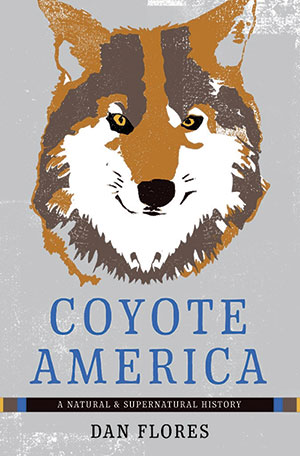Top: Coyotes are found in every Florida county although they’re more likely to be heard than seen. Photo courtesy Adobe Stock.
Families who have lost pets to the growing number of coyotes living in the Tampa Bay region certainly won’t appreciate this book, but others will discover that it’s a fascinating tale about an incredibly adaptable animal that is thriving even in highly dense areas like Pinellas County.
Coyote America: A Natural & Supernatural History by Dan Flores (Peresus Books Group, 271 pages) takes a look at the fall and then the rise of the American coyote, which evolved in the American Southwest and then later spread to Eurasia, South America and eventually to Africa, where they are known as jackals. They have lived successfully among humans — perhaps even intentionally sought them out — for more than 15,000 years. Coyote populations continue to grow today, even after what Flores describes as a “crusade against their kind that surpassed any other in recorded history in terms of the range of killing techniques and cruelty.”
 The author clearly admires the wily coyote, noting that it played an important role in almost every Native American religion and that no other creature — real or mythical — inspired as many tales in traditional oral literature. In fact, many Southwestern Hispanics still believe that the “only thing smarter than a coyote is God.”
The author clearly admires the wily coyote, noting that it played an important role in almost every Native American religion and that no other creature — real or mythical — inspired as many tales in traditional oral literature. In fact, many Southwestern Hispanics still believe that the “only thing smarter than a coyote is God.”
That’s hard to argue with, considering their populations have grown so much they’re found in every Florida county, as well as highly urbanized cities like New York and Chicago, where one strolled into a Quizno’s sandwich shop in broad daylight during a 2007 heatwave and hopped up on a freezer to cool off.
Flores attributes much of their success to their amazing ability to adapt to changing environmental conditions. When large grazing animals began to disappear from the American plains as part of the Pleistocene extinction, wolves became scarcer as their food supply shrunk. Coyote populations, on the other hand, continue to grow and expand because the animals evolved into smaller creatures that needed less to eat and could survive on smaller prey. They learned to live as individual animals and became scavengers and omnivores instead of hunting large game in packs.
“The story of the coyote in the American West and beyond is a story of Manifest Destiny in reverse, with a pioneering hero whose career holds up an uncanny mirror to the successes and failures of American expansionism,” Flores says.
Coyote in Florida
Even with nearly no government protection, coyote populations continue to grow in Florida and across the country. Their success comes from their ability to live in almost any habitat – forest, wetlands, parks, even suburbs with small natural areas – and their opportunistic outlook on food, from small animals (including cats) to dog food and even garbage. If they are trapped or killed, the next litter of pups from the remaining animals is likely to be larger to take advantage of the increased land and food.
Except to small pets, they are not likely to be dangerous. Coyote bites are rare and only about two human deaths occur per year (compared with nearly 200 deaths from dog bites), usually when humans have been feeding them or interrupt their feeding. With a body shape similar to that of a collie, pointed ears and bushy tails, coyotes typically weigh less than 30 pounds. They rarely contract rabies but have been known to have heartworms. Coyotes are seldom seen, but often heard, particularly in areas near parks. Their unique vocalizations starts with a bark and ends with a howl. (Listen here)
If you have seen or heard coyotes in your neighborhood, follow these tips from the Florida Fish and Wildlife Conservation Commission to protect yourself and your pets:
- Do not feed them. Particularly do not leave food or garbage out overnight. Even bird seed or fallen fruit can attract these omnivores.
- Do not allow cats to roam or dogs out alone. Walk carefully at dawn and dusk when they are most active.
- Coyotes are generally shy, fearful animals but if one approaches, frighten it away by making loud noises and acting aggressively. FWC suggests waving your arms in the air, throwing sticks at it or spraying it with a hose.
- Close off crawl spaces under porches and sheds. Coyotes and other animals (including opossums) use such areas for resting and raising young.
- Teach children to recognize and not to run from coyotes. If children are approached, have them move slowly into a house or climb up on a swing, tree or deck and yell.
Learn more at the Florida Fish and Wildlife Conservation Commission or at Pinellas County Animal Services which includes a map of 2016 coyote sightings in Pinellas County. Holly Greening, executive director of the Tampa Bay Estuary Program since its inception 25 years ago.
